
The Commandos Marine, nicknamed Bérets Verts, are the special operation forces (SOF) of the French Navy, headquartered in Lorient, Brittany in western France. They operate under the Special Operations Command (COS), FORFUSCO, one of the four main forces of the French Navy or any operational command designated by the French Army staff. They specialize in offshore operations; operations from sea to land and special operations on land. One of the major characteristics of marine commando units is to be perfectly interoperable with all the resources and units of the navy.

In the Vietnam War, the Mobile Riverine Force (MRF) (after May 1967), initially designated Mekong Delta Mobile Afloat Force, and later the Riverines, were a joint US Army and US Navy force that comprised a substantial part of the brown-water navy. It was modeled after lessons learned by the French experience in the First Indochina War of Dinassaut and had the task of both transport (of soldiers and equipment) and combat. The primary land base was at Đồng Tâm Base Camp, with a floating base which operated in the major rivers of the Mekong Delta. Soldiers and sailors went out in river boats from the floating base to assault the Viet Cong. During part of the 1968-69 period, there were two such mobile bases operating in different parts of the Delta, Mobile Riverine Groups Alpha and Bravo. The MRF played a key role in the Tet Offensive.

Operation Sealords was a military operation that took place during the Vietnam War.

A brown-water navy or riverine navy, in the broadest sense, is a naval force capable of military operations in littoral zone waters. The term originated in the United States Navy during the American Civil War, when it referred to Union forces patrolling the muddy Mississippi River, and has since been used to describe the small gunboats and patrol boats commonly used in rivers, along with the larger "mother ships" that supported them. These mother ships include converted World War II-era mechanized landing craft and tank landing ships, among other vessels.

The landing craft, vehicle, personnel (LCVP) or Higgins boat was a landing craft used extensively by the Allied forces in amphibious landings in World War II. Typically constructed from plywood, this shallow-draft, barge-like boat could ferry a roughly platoon-sized complement of 36 men to shore at 12 knots. Men generally entered the boat by climbing down a cargo net hung from the side of their troop transport; they exited by charging down the boat's lowered bow ramp.
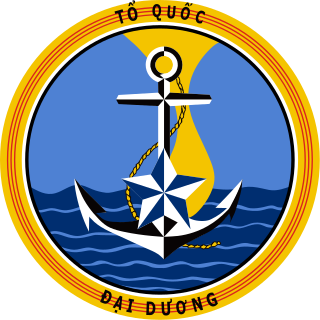
The Republic of Vietnam Navy (RVNN; Vietnamese: Hải quân Việt Nam Cộng hòa - HQVNCH; was the naval branch of the South Vietnamese military, the official armed forces of the former Republic of Vietnam from 1955 to 1975. The early fleet consisted of boats from France; after 1955, and the transfer of the armed forces to Vietnamese control, the fleet was supplied from the United States. With American assistance, in 1972 the VNN became the largest Southeast Asian navy and, by some estimates, the fourth largest navy in the world, just behind the Soviet Union, the United States and the People's Republic of China, with 42,000 personnel, 672 amphibious ships and craft, 20 mine warfare vessels, 450 patrol craft, 56 service craft, and 242 junks. Other sources state that VNN was the ninth largest navy in the world. The Republic of Vietnam Navy was responsible for the protection of the country's national waters, islands, and interests of its maritime economy, as well as for the co-ordination of maritime police, customs service and the maritime border defence force.

The landing craft mechanized (LCM) is a landing craft designed for carrying vehicles. They came to prominence during the Second World War when they were used to land troops or tanks during Allied amphibious assaults.

Armored Troop Carriers (ATC), often called Tangos from the phonetic alphabet for T, were LCM-6 landing craft modified for riverine patrol missions. They were used by the Mobile Riverine Force (MRF) of the United States Army and Navy in the Vietnam War. They were also used by Republic of Vietnam Navy (RVNN) and Khmer National Navy.
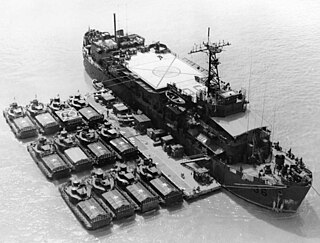
USS Colleton (APB-36), was a Benewah-class barracks ship. Colleton's keel was laid on 9 June 1945, launched on 30 July 1945 and delivered on 27 September 1946. She was berthed at Boston, Massachusetts in the custody of the United States Maritime Commission.
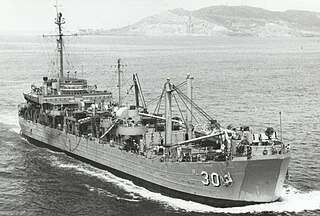
USS Askari (ARL-30) was one of 39 Achelous-class landing craft repair ships built for the United States Navy during World War II. Askari is an Arabic word for soldier, a term frequently applied to indigenous troops in Africa serving European colonial powers, particularly the British and Germans in East Africa from the late 19th century to the end of World War I; ARL-30 has been the only U.S. naval vessel to bear the name.

Operation Game Warden was a joint operation conducted by the United States Navy and South Vietnamese Navy in order to deny Viet Cong access to resources in the Mekong River Delta. Game Warden and its counterpart Operation Market Time are considered to be two of the most successful U.S. Naval actions during the Vietnam War.

USS Madera County (LST-905) was a LST-542-class tank landing ship built for the United States Navy during World War II. Named after Madera County, California, she was the only U.S. Naval vessel to bear the name.

USS Oak Hill (LSD-7) was an Ashland-class dock landing ship of the United States Navy, named in honor of Oak Hill, the Virginia estate of President James Monroe (1758–1831).
Riverine artillery refers to artillery employment on a river, generally on floating barges. Transport of field artillery is difficult through the moist ground and riparian forest adjacent to low-gradient rivers. Traditional naval artillery is mounted on deep-draft vessels unsuited for operations in shallow rivers.

Operation Truong Cong Dinh, was a United States and Army of the Republic of Vietnam (ARVN) security operation to reestablish South Vietnamese control over the northern Mekong Delta in the aftermath of the Tet Offensive. The operation aimed to root out Viet Cong (VC) forces in the area, and to stop them from attacking traffic on the nearby Highway 4.

The motor landing craft (MLC) was a vessel used in the 1920s and 30s. It was specifically designed to deliver a tank to shore and may be considered the predecessor of all Allied landing craft mechanised (LCM). The MLC also saw action in the first year of the Second World War. Its primary purpose was to ferry tanks, troops and stores from ships to shore. The craft derived from discussions of the Landing Craft Committee; the prototype was designed by J. Samuel White of Cowes.
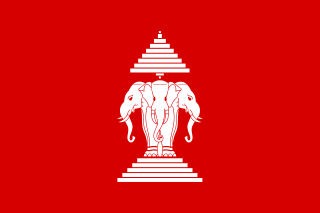
The Royal Lao Navy was the naval component of the Royal Lao Armed Forces (FAR), the official military of the Royal Lao Government and the Kingdom of Laos during the Laotian Civil War between 1960 and 1975.

The Khmer National Navy was the naval component of the Khmer National Armed Forces (FANK), the official military of the Khmer Republic during the Cambodian Civil War between 1970 and 1975.
The Coastal Riverine Force (CORIVFOR) is a unit of the United States Navy within the organizational structure of the Navy Expeditionary Combat Command (NECC). The unit was established following the merger of Riverine Group 1 and the Maritime Expeditionary Security Group 1 & 2 on June 1, 2012. Its express purpose is to provide port and harbor security, and offshore protection for maritime infrastructure and Military Sealift Command ships operating in coastal waterways.
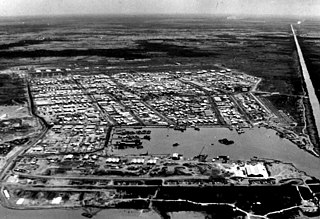
Đồng Tâm Base Camp is a former U.S. Army, U.S. Navy, and Army of the Republic of Vietnam (ARVN) base west of Mỹ Tho in the Mekong Delta, southern Vietnam.

















